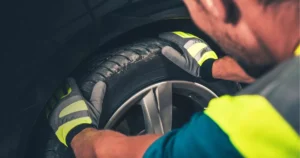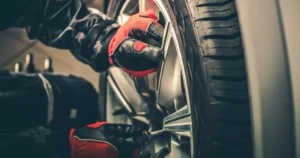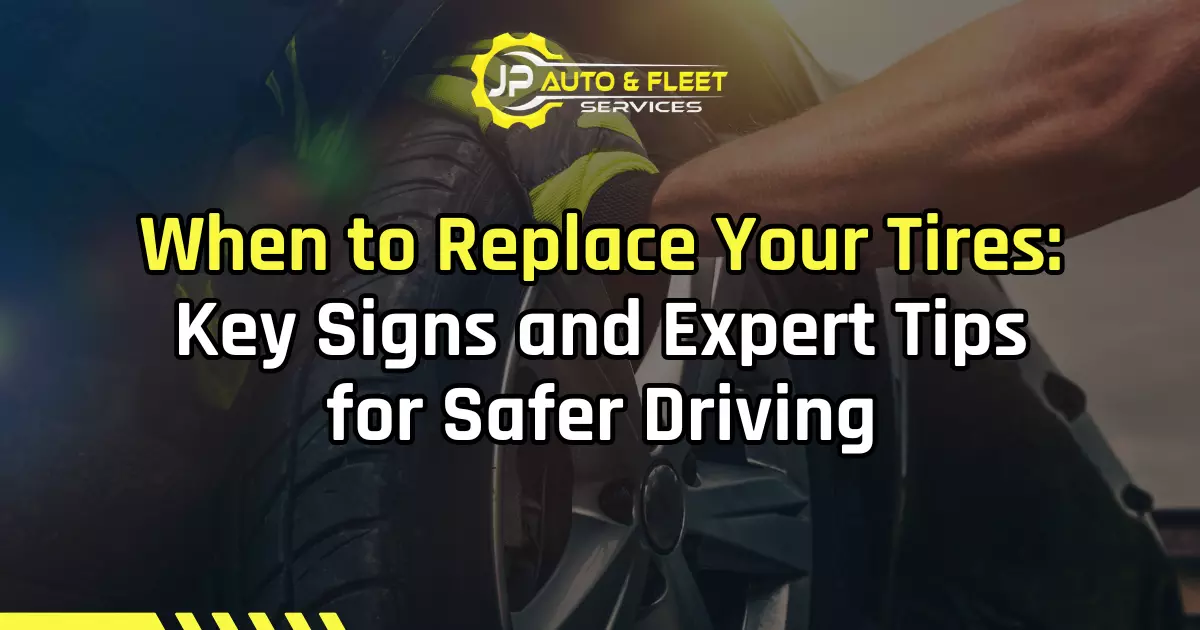Knowing when to replace your tires helps keep your car safe and steady on the road. You should replace worn-out tires to avoid tire failure, dangerous blowouts, and expensive tire repairs. Over time, tread depth gets lower, tire pressure changes, and tire sidewalls may crack or form bubbling tires. Things like driving conditions, alignment issues, and extreme temperatures can damage your tires. Knowing the warning signs will help you keep your tires in good shape and drive safely.
Read on to learn how to spot worn-out tires and pick the best replacement tires.
Why Is It Important to Know When to Replace Your Tires?

Tires get damaged over thousands of miles of travel. Tire tread depth gets lower, and uneven tire wear or cracks in the tire sidewalls may also appear. Ignoring these warning signs can cause tire failure, expensive tire repair, or even dangerous blowouts in adverse conditions. Tire age, storage conditions, and driving habits also affect how long your tires last. By doing regular tire inspections, you can avoid problems and enjoy a safer, smoother ride.
Below, we explore why recognizing the right time for tire replacement is essential.
Improved Safety
Tires are the first thing protecting your car on the road. A worn tire or bad tires can lose grip, especially on wet roads, and increase the chance of accidents. Tread grooves and tread blocks push water away, but shallow tread depth stops them from working well. Check for uneven tire wear, bubbling tires, and flat tires during regular tire inspections. Use a tire pressure monitoring system to keep the air pressure right and avoid underinflated tires, which can overheat and cause problems. Replace your tires when only an inch of tread remaining is visible or if warning lights show issues.
Enhanced Performance
Replacing tires on time helps your car handle and stay steady. Modern tires make acceleration, braking, and cornering smooth and safe. However misaligned wheels or a suspension issue can reduce how well they perform. Pick quality tires that match your car’s tire type, and do tire rotations to keep uneven tire wear from happening. A competent tire workshop can check for common issues and suggest the best replacement tires.
Increased Fuel Efficiency
Worn-out tires with low tire pressure or uneven tire wear make your car use more gas. Using quality tires with the right tread patterns can save energy and improve gas mileage. All-season tires and other tire models that roll easily help your car perform better. Check the rubber compounds to make sure they are strong and replace defective tires quickly. Regular checks, like fixing air leaks and doing tire repairs, will keep your car running smoothly and save fuel.
Read also: Fuel Management System
Longer Vehicle Lifespan
Replacing tires on time helps protect your car’s shock absorbers and suspension system. Problems like underinflated tires or wheel misalignment can damage these parts. Using the right type of tires for your driving conditions reduces wear on your car. Doing regular tire inspections and checking with tire retailers can find problems early. Getting replacement tires from a good tire shop helps your car last longer and stay safe to drive.
How Can You Tell If Your Tire Tread Is Too Worn?

Knowing when your tire tread is too worn is important for safe driving. A worn tire loses grip on wet roads, making it harder to control your car and increasing the chance of tire failure. Uneven tire wear, low air pressure, or damage like cracks and bulges are warning signs that it’s time to replace your tires. Simple tire checks, like a visual inspection or easy tests, can help you find problems early.
Below, we discuss the types, benefits, and importance of checking tires to keep your cars in good shape.
Conduct the Penny Test
The penny test is an easy way to check your tire tread. Take a common coin, like a penny, and put it into the tread grooves with Lincoln’s head facing down. If you can see the top of his head, your tread depth is too low, and you need to replace your tires. This method is useful, but getting a check from a competent tire workshop gives better accuracy. Regular checks keep your tires safe and in good condition.
Understand Tread Depth
Tread depth is important for keeping your tires safe and able to grip the road. A tread groove less than 2/32 of an inch is a telltale sign of a worn-out tire. Shallow treads make it harder to stop and can cause hydroplaning on wet roads in bad weather conditions. Using tools to check the depth of the tire tread helps you see if your tires are safe. Regular tire checks keep your car’s primary function working well and help avoid problems.
Follow Legal Tread Depth Limits
The legal limit for tire tread depth is usually around 2/32 of an inch, but it can vary by region. Driving with treads below this limit can cause fines and make you more responsible in accidents. Staying above the limit also protects your tires from damage and keeps your car safe. Following these rules helps you drive safely in different weather conditions. Regular tire checks and tire rotations can keep your tread depth within legal limits.
Check for Visible Cracks, Bulges, and Blisters
Cracks in tire sidewalls or bubbling tires mean there is a problem inside the tire. These can happen because of extreme temperatures, poor storage conditions, or long use over thousands of miles. This kind of damage weakens the rubber compounds and can cause flat tires or blowouts while driving fast. Doing regular inspections or visiting a tire shop can help you find these problems early.
Watch Out for Uneven Tire Wear
Uneven tire wear can mean problems like wheel misalignment, a suspension issue, or underinflated tires. It reduces grip and makes tire failure more likely, especially in the rear tire or other spots. This type of wear can also shorten the tire life and cause a rough ride. Doing regular tire rotations with crisscross tire rotation patterns helps spread out the wear evenly.
Monitor Persistent Air Pressure Loss
If your tire pressure keeps dropping after refilling, it might mean damage to the outer layers or tire surface. This can happen because of punctures, bad valve seals, or defects in modern tires. A tire pressure monitoring system can help you track changes and fix problems early. Regular tire checks stop further damage and keep the air pressure correct.
How Can You Choose the Right Tires for Replacement?

Picking the right replacement tires keeps your car safe and working well. Choosing carefully helps avoid tire failure, bad handling, and poor fuel use. Think about the tire type, size, and quality of tires, and check the details that match your car. Visiting a competent tire workshop and getting professional installation makes your tires last longer.
Below, we explore the essential aspects of making an informed tire purchase decision.
Consider Tire Type, Size, and Quality
Choosing the right tire type depends on your car, how you drive, and the weather conditions. For snowy areas, winter tires are important, while all-season tires work well in mild climates. The size of the tire also matters because the wrong size or a different-sized tire and wheel combination can cause suspension issues and uneven tire wear. Buying quality tires gives better grip, lasts longer, and avoids tire damage. Always check your car’s manual or ask a tire manufacturer to find the right size and type.
Read Tire Labels and Specifications
Tire labels show important details like size, load capacity, and speed rating. Knowing these numbers helps you pick tires that fit your car. Check the tread patterns, center tire grooves, and rubber compounds, as these affect how well your tires work on wet roads and in extreme temperatures. Keep an eye on tread depth and watch for common signs of wear. Tires with less than 2/32 inches of tire tread are unsafe to use.
Choose Trustworthy Tire Shop
A good tire shop should offer a wide array of tires and services with clear pricing. Trusted tire retailers or auto repair shops like JP Auto & Fleet Services provide expert help to find the right tires for you. The shop should do visual inspections, check air pressure, and offer fair tire prices. Avoid picking the cheapest tire if it means losing quality tires. A reliable shop helps you get safe and long-lasting tires for your car.
Read also: Auto Care Near Me
Opt for Professional Tire Installation
Proper tire installation helps prevent air leaks, misaligned wheels, or balance issues. Trained workers make sure your tires are put on and balanced correctly for a safe and smooth ride. They also check if your tires work with rear-wheel drive or 4-Wheel Drive systems. This helps your modern tires last longer and work better. Combine this with regular tire inspections to keep your car safe and your tires in good shape.
How to Prolong the Life of Your New Tires?

To make your new tires last longer, you need regular care and careful driving. This keeps your ride smooth and avoids problems like uneven tire wear, flat tires, and early tire failure. Keep the air pressure at the correct level to protect your quality tires. Fix any alignment issues and do tire rotations often. These simple steps help your tires stay strong and last for thousands of miles.
Below, we explore the most effective ways to preserve and maximize your tires’ value.
Follow Proper Inflation
Keeping the right tire pressure is important to avoid underinflated tires. Low pressure can cause heat buildup, reduce tread depth, and increase rolling resistance. A tire pressure monitoring system can alert you to changes and air leaks. Inflate your tires to the levels recommended by the tire manufacturer for your car’s tire type. Proper inflation stops tire damage and improves performance on wet roads and in extreme temperatures.
Have Alignment Maintenance
Bad alignment causes uneven tire wear and shortens the tire life. It can happen because of aggressive driving, hitting potholes, or normal wear over thousands of miles. A competent tire workshop can check for wheel misalignment or a suspension issue. Fixing alignment makes sure your tires wear evenly and last longer.
Rotate and Balance Your Tires Regularly
Tire rotations help wear your tires evenly, which is important for rear-wheel drive or 4-Wheel Drive cars. Rotate your tires in a crisscross pattern every 6,000 to 8,000 miles to avoid wearing out certain tires faster. Balancing tires makes sure the weight is even, reduces shaking, and improves grip. These steps protect your tread blocks, keep tread depth even, and make your tires last longer.
Wrapping Up
Knowing how to do tire replacement is essential for maintaining your vehicle and is critical for safe driving. Paying attention to telltale signs like tire tread depth, uneven tire wear, and persistent air pressure loss can prevent issues like flat tires, improve your vehicle’s performance, and ensure peace of mind on the road.
If you’re unsure about the condition of your tires, JP Auto & Fleet Services’ tire replacement service is here to help. Our expert team provides visual inspections, professional installation, and a wide selection of quality tires to suit all tire types and weather conditions. With unmatched expertise and competitive pricing, we ensure a seamless, worry-free experience.
Don’t wait for warning signs to worsen—visit JP Auto & Fleet Services today and enjoy safer, smoother driving tomorrow!


